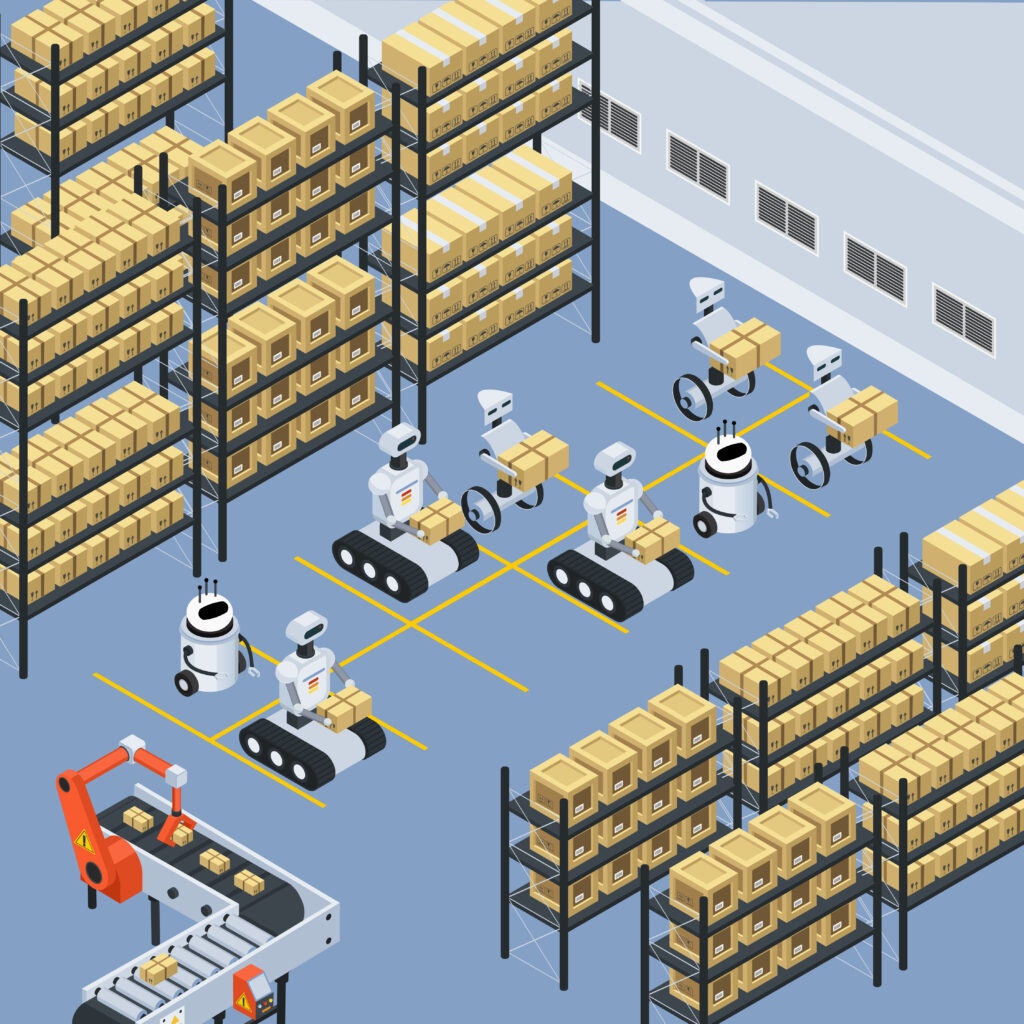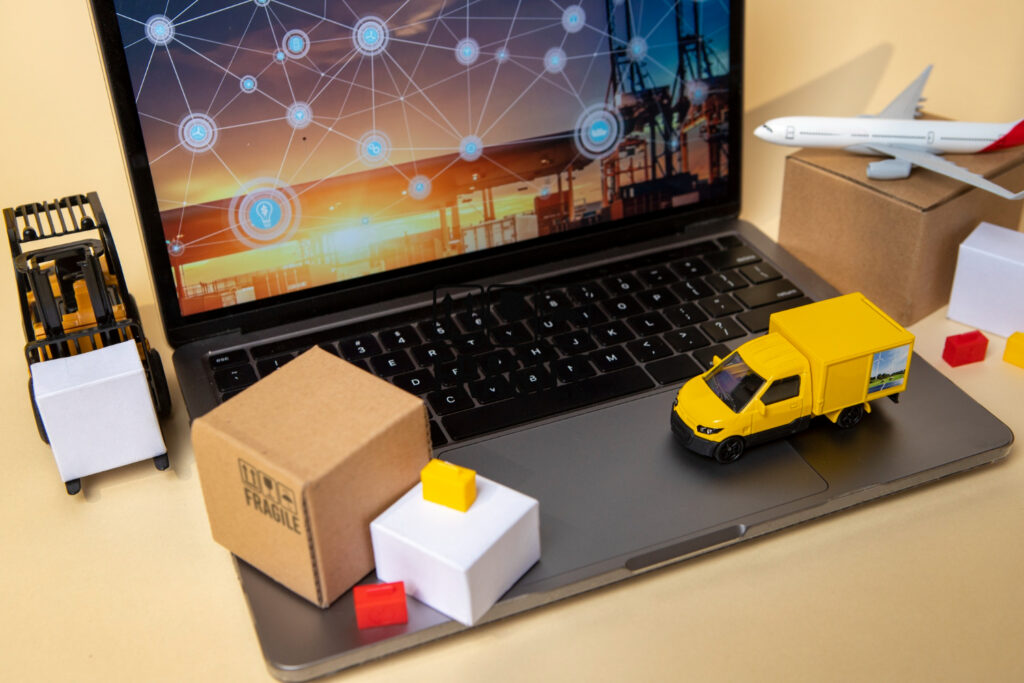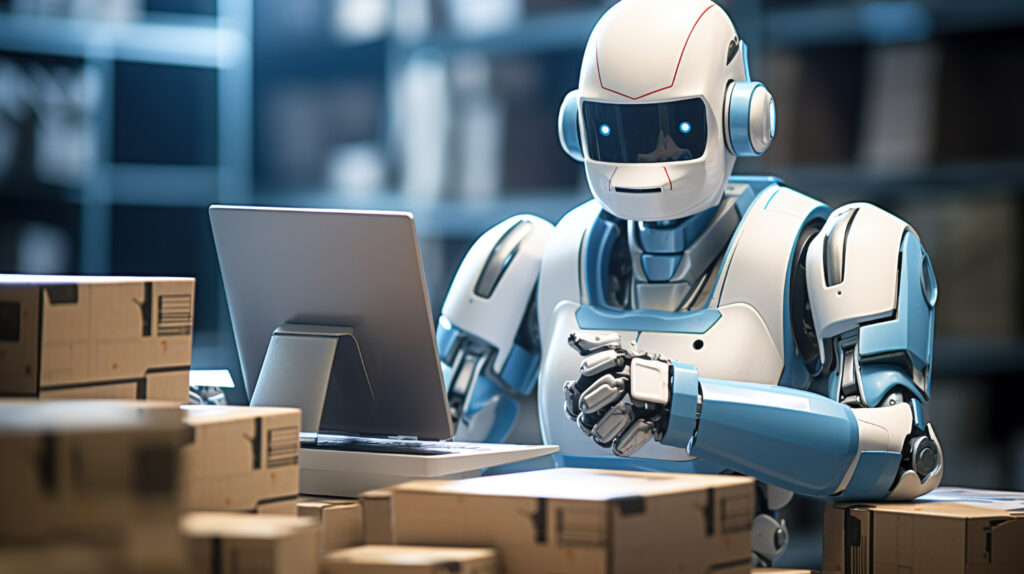Discover Our
Latest Posts
In today’s fast-paced logistics industry, the need for efficiency, flexibility, and scalability has never been more crucial. As companies face increasing demand, tighter delivery windows, and complex supply chains, relying on off-the-shelf software can limit growth. This is where custom logistics software development comes into play, offering tailored solutions to address unique business challenges and optimize operations.
But building scalable logistics software isn’t as simple as choosing features and launching. Logistics companies must consider key factors to ensure their software can grow alongside the business, stay resilient, and provide lasting value. Here’s a guide to help you navigate the journey of custom software development for logistics.
1. Understand Your Business Needs and Challenges
The first step to developing custom logistics software is understanding the specific challenges your business faces. Does your company struggle with tracking shipments in real-time? Are warehouse operations inefficient? Do you need better integration across platforms? Identifying these pain points allows you to create software tailored to solving your specific needs.
2. Focus on System Integration
Logistics operations involve multiple systems — from transportation management systems (TMS) and warehouse management systems (WMS) to enterprise resource planning (ERP) platforms. A custom solution should integrate seamlessly with existing systems, allowing smooth data flow between different departments and stakeholders. A well-integrated system breaks down silos, improves visibility, and streamlines decision-making processes.
3. Prioritize Scalability
Your logistics software should not only meet current business requirements but also be flexible enough to scale as your operations grow. Whether it’s accommodating more users, handling higher transaction volumes, or integrating new features, a scalable architecture ensures your software can evolve with your business. Cloud-based solutions, modular design, and microservices architecture are key approaches to building scalable systems.
4. Leverage Artificial Intelligence and Automation
AI-driven features such as predictive analytics, route optimization, and demand forecasting are game-changers for logistics companies. Automating repetitive tasks like scheduling deliveries or managing inventory can save time and reduce human error. Building AI capabilities into your custom software will future-proof your operations, allowing you to stay ahead in an increasingly automated logistics landscape.
5. Incorporate Blockchain for Transparency and Security
Blockchain technology can provide secure and transparent record-keeping for logistics processes, such as tracking shipments, verifying transactions, and managing contracts. By incorporating blockchain into your custom software, you can ensure traceability, minimize fraud, and enhance trust across the supply chain.
6. Plan for User Experience (UX) and Mobility
Custom software isn’t just about functionality; it’s about making life easier for the users. Whether it’s your warehouse staff, drivers, or back-office teams, the software should be intuitive and user-friendly. In addition, with mobile devices becoming an integral part of logistics operations, ensuring your software is mobile-friendly will enhance accessibility and efficiency on the go.
7. Focus on Data Security and Compliance
Logistics companies handle sensitive data, from customer details to shipping information. Data breaches can be costly, both financially and reputationally. Ensure your custom logistics software adheres to the latest security protocols, including encryption, multi-factor authentication, and regular security audits. Compliance with industry standards such as GDPR is also critical for global operations.
8. Work with Experienced Development Partners
Building custom software is a complex endeavor that requires the right expertise. Partnering with an experienced IT services company that understands the logistics industry can make all the difference. They can provide valuable insights, mitigate risks, and ensure the software is built to meet both your current and future needs.
Conclusion
Custom logistics software development is a strategic investment that can transform your business by optimizing operations, enhancing scalability, and addressing unique challenges. By focusing on key considerations like system integration, scalability, AI, and security, logistics companies can build robust solutions that support long-term growth. As the logistics landscape continues to evolve, having the right custom software in place will help your business stay competitive and ready for the future.
Is your logistics business ready to take the leap toward custom software development? Let us help you build a solution that scales with your needs.
In today’s fast-paced logistics world, where speed and accuracy are paramount, warehousing operations have become a critical focal point for businesses seeking efficiency. One of the most transformative technologies reshaping this industry is AI-driven automation, powered by artificial intelligence (AI) and machine learning (ML). These advancements are revolutionizing warehouse operations, from inventory management to order fulfillment, offering unprecedented opportunities for growth, accuracy, and cost savings.
The Rise of AI in Warehousing
Traditional warehousing operations rely heavily on manual processes, leading to inefficiencies, errors, and delays. Enter AI-driven automation, where intelligent systems work tirelessly to streamline these processes, reducing human error and improving operational efficiency. The implementation of AI solutions in warehousing allows for smarter decisions, faster processes, and a drastic reduction in operational costs.
AI in Inventory Management
At the core of every warehouse is inventory management, a complex task that involves tracking, organizing, and ensuring the availability of products. AI and machine learning have transformed this traditionally manual process into a real-time, data-driven operation. Here’s how:
- Demand Forecasting: AI algorithms analyze historical data and market trends to predict future demand accurately. This prevents overstocking or understocking, ensuring the right amount of inventory is always available.
- Real-Time Tracking: With AI-driven systems, warehouses can track stock levels in real time, providing visibility into inventory at every stage. This enables faster decision-making and reduces the risk of stockouts or overordering.
- Smart Restocking: AI can automatically trigger restocking orders when inventory levels hit predefined thresholds, ensuring seamless operations without human intervention.
Automating Order Fulfillment
Beyond inventory management, AI is playing a significant role in order fulfillment. Machine learning algorithms, combined with robotics, are automating key parts of the fulfillment process, enhancing speed and precision:
- Automated Picking Systems: AI-powered robots and automated guided vehicles (AGVs) are transforming how warehouses pick and pack products. These systems identify the fastest and most efficient routes to pick items, reducing human errors and speeding up fulfillment times.
- Dynamic Slotting: AI analyzes order patterns and places high-demand products in optimal locations within the warehouse, reducing picking times and improving the overall efficiency of the fulfillment process.
- Order Accuracy: AI-driven systems constantly monitor order accuracy, catching discrepancies before they become costly issues. This leads to higher customer satisfaction as orders are delivered on time and without error.
The Future of AI in Warehousing
As AI continues to evolve, the possibilities for warehousing automation are endless. Predictive analytics, advanced robotics, and real-time decision-making will soon become standard practices, transforming warehouses into fully autonomous hubs of efficiency. Businesses that invest in AI-driven automation today will not only see immediate improvements in their operations but will also future-proof their supply chains for the challenges of tomorrow.
Why Invest in AI-Driven Warehousing Automation?
For businesses seeking to stay competitive, the benefits of AI-driven automation are clear:
- Increased Efficiency: Automating repetitive tasks like inventory management and order fulfillment boosts productivity and allows human workers to focus on higher-value tasks.
- Reduced Costs: With AI optimizing operations, businesses can reduce labor costs, minimize errors, and improve overall efficiency.
- Improved Scalability: AI systems can easily scale as a business grows, ensuring that warehousing operations can handle increasing volumes without losing efficiency.
In conclusion, AI-driven automation is not just a trend—it’s the future of warehousing. By leveraging the power of artificial intelligence and machine learning, businesses can transform their inventory management and order fulfillment processes, driving efficiency, accuracy, and growth in a rapidly evolving industry.
In the fast-paced world of international shipping, ensuring security, transparency, and trust is paramount. With billions of dollars’ worth of goods moving across borders daily, the logistics industry faces complex challenges—chief among them is the risk of fraud and the lack of transparency that can hinder smooth operations. Enter blockchain technology, a game-changing solution with the potential to transform how goods are tracked, verified, and trusted in cross-border logistics.
The Global Logistics Challenge: Fraud and Trust
Cross-border logistics involves multiple stakeholders—manufacturers, shippers, customs agents, and distributors—each handling critical information and documentation. With so many touchpoints, there is ample room for data tampering, shipment fraud, and unauthorized modifications to records. Traditional systems often struggle with slow, error-prone manual processes, leaving gaps in security and opportunities for fraud to occur.
Blockchain, a decentralized and immutable digital ledger, provides an innovative way to address these challenges. By applying blockchain to logistics, companies can reduce fraud, enhance data transparency, and create a more secure and trusted global supply chain.
How Blockchain Secures Transactions in Logistics
At its core, blockchain ensures that each transaction or exchange of information is time-stamped, verified, and stored on a distributed ledger that cannot be altered. In logistics, this means every movement of goods—from manufacturer to end user—can be traced with pinpoint accuracy. Here’s how blockchain improves transaction security:
- Immutable Records: Blockchain’s decentralized nature ensures that once a transaction is recorded, it cannot be modified or tampered with, providing an unchangeable log of events.
- End-to-End Transparency: Every participant in the supply chain has access to the same real-time data, allowing stakeholders to verify the authenticity of shipments and reduce the risk of false claims.
- Smart Contracts: These self-executing contracts can automate payment processes upon the fulfillment of predetermined conditions, ensuring payments are only made when terms are met, reducing the risk of fraudulent financial transactions.
Reducing Fraud in Cross-Border Transactions
Fraud in logistics can take many forms, from counterfeit goods to false customs declarations. Blockchain’s ability to track every step of the shipping process helps reduce these risks:
- Product Verification: Blockchain allows companies to verify the authenticity of goods at every stage, ensuring that what leaves the factory is what arrives at its destination.
- Customs Compliance: Blockchain can automate the documentation process, allowing customs authorities to instantly verify the contents of a shipment, reducing the likelihood of underreporting or misrepresentation.
- Preventing Double Spending: Blockchain eliminates the possibility of double financing or duplicated payments by providing a transparent record of all transactions, reducing financial fraud.
Fostering Trust in International Shipping
Trust is critical in global logistics, where stakeholders often operate across different jurisdictions and regulatory frameworks. Blockchain fosters trust in several ways:
- Shared Data Access: All parties have access to the same verified data, promoting trust between stakeholders who may not have a direct relationship but need to collaborate.
- Real-Time Tracking: Blockchain’s ability to record every movement of goods in real time allows companies and customers to track shipments, ensuring accountability and fostering trust at every step.
- Dispute Resolution: With an immutable record of transactions, blockchain makes it easier to resolve disputes, as all parties can access a clear and indisputable history of events.
A Future of Trusted, Fraud-Free Global Logistics
As the logistics industry continues to grow, blockchain technology offers a transformative solution to longstanding issues of fraud and mistrust. By leveraging blockchain, companies can secure their supply chains, reduce fraud, and foster a higher level of trust among global stakeholders. With the power to verify, automate, and secure every transaction, blockchain is not just the future of logistics—it is the key to a more transparent, trusted global trade system.
In today’s fast-paced logistics industry, where speed, efficiency, and accuracy are essential, having access to real-time data is a game-changer. However, many logistics companies are still grappling with one critical obstacle: data silos. When different systems across the logistics ecosystem don’t communicate effectively, critical information gets trapped in isolated pockets, slowing down decision-making, reducing efficiency, and increasing the risk of errors. This is where system integration comes in, transforming logistics operations by breaking down these silos and providing a holistic view of the entire supply chain.
The Challenges of Data Silos in Logistics
Logistics operations involve a wide range of processes—inventory management, shipping, order tracking, warehouse management, and more. Each of these functions often relies on specialized software systems that don’t naturally communicate with one another. The result? Data silos that prevent organizations from having a unified view of their logistics operations.
These silos lead to several challenges:
- Delayed decision-making: When data is scattered across different platforms, gathering insights becomes a time-consuming process, delaying critical decisions.
- Inconsistent data: Without system integration, companies may encounter discrepancies in data across platforms, leading to inaccurate reporting and operational inefficiencies.
- Reduced visibility: A fragmented data landscape can obscure visibility into the supply chain, making it harder to track shipments, monitor inventory levels, and forecast demand.
The Power of System Integration in Logistics
System integration addresses these challenges by connecting disparate systems into one cohesive platform. With integrated systems, logistics companies can unlock the full potential of their data, streamlining operations and enhancing decision-making. Here’s how:
- Unified Data Access : System integration provides a single source of truth by consolidating data from various systems, such as transportation management systems (TMS), warehouse management systems (WMS), and customer relationship management (CRM) tools. This unified view allows logistics managers to access real-time data at any point in the supply chain, from inventory levels to delivery status, without jumping between platforms.
- Enhanced Decision-Making: When all data is integrated, decision-makers can act faster and more accurately. Integrated systems enable logistics managers to make informed decisions about route optimization, delivery schedules, and inventory management, based on complete and up-to-date information.
- Increased Operational Efficiency: Integrating systems eliminates redundant tasks, such as manually transferring data between systems. Automation becomes more feasible, allowing tasks like order processing, shipment tracking, and invoicing to be handled more efficiently.
- Improved Customer Experience: Customers today expect transparency and real-time updates about their shipments. With integrated systems, logistics companies can provide customers with up-to-the-minute tracking information and faster response times, improving customer satisfaction.
- Scalability and Flexibility: As logistics businesses grow, their operational complexity increases. Integrated systems provide the flexibility to scale operations without the chaos of disconnected data streams. Whether expanding into new markets or adding new partners, integrated systems make scaling smoother and more manageable.
Making System Integration a Priority
System integration is no longer a luxury for logistics companies—it’s a necessity. As the industry becomes more complex, having siloed systems not only limits efficiency but also hinders innovation. By breaking down data silos and integrating disparate systems, logistics companies can harness the full power of their data to drive better decision-making and stay competitive in a fast-moving market.
The future of logistics is digital, and system integration is the key to unlocking its potential. Companies that invest in integration today will be better positioned to streamline operations, reduce costs, and deliver exceptional service to their customers tomorrow.
In the fast-paced world of logistics, companies face increasing pressure to deliver goods quickly, efficiently, and at a lower cost. As the demands of the supply chain grow, so too does the need for smarter, more agile solutions to manage everything from inventory to delivery. Enter Artificial Intelligence (AI)-powered predictive analytics, a game-changing innovation that is transforming logistics by helping companies. forecast demand, optimize routes, and significantly reduce operational costs.
Forecasting Demand: Preparing for the Future
One of the most critical elements of logistics is being able to predict demand accurately. Traditionally, logistics companies relied on historical data, market trends, and human judgment to anticipate needs. However, with the integration of AI-powered predictive analytics, logistics companies can now leverage real-time data and machine learning algorithms to produce highly accurate demand forecasts.
These AI-driven models analyze patterns in purchasing behavior, seasonal trends, and external factors like weather and political events. This allows logistics companies to better prepare for demand fluctuations, ensuring they have the right amount of inventory, vehicles, and staff ready to meet the market’s needs. As a result, businesses can avoid overstocking or understocking, both of which are costly inefficiencies.
Optimizing Routes: The Key to Speed and Efficiency
Another critical area where AI is making a significant impact is in route optimization. Logistics companies constantly seek to minimize delivery times while maximizing fuel efficiency. Traditional route planning, while effective, is often static and unable to adapt to changing road conditions, traffic patterns, or sudden disruptions.
With AI-powered predictive analytics, companies can dynamically adjust routes in real-time. These systems analyze live traffic data, weather conditions, and even vehicle performance to identify the most efficient paths. AI can also predict potential delays and suggest alternate routes to avoid them. This capability ensures faster deliveries, reduces fuel consumption, and minimizes wear and tear on vehicles—all of which translate to substantial cost savings.
Reducing Operational Costs: Efficiency Through Innovation
One of the most tangible benefits of using AI in predictive analytics is the reduction in operational costs. By optimizing demand forecasting and route planning, logistics companies can reduce waste in the form of excess inventory, unused capacity, or idle time.
Additionally, AI can assist in predictive maintenance, where it monitors the performance of vehicles and equipment to forecast potential failures before they occur. This allows logistics companies to carry out maintenance proactively, reducing downtime and avoiding costly repairs. By keeping their fleets in optimal condition, companies can ensure smoother operations and extend the lifespan of their assets.
The Competitive Advantage of AI-Powered Logistics.
The integration of AI into predictive analytics is not just about cost-cutting; it’s about gaining a competitive edge in a highly saturated market. Logistics companies that embrace AI are able to offer faster, more reliable services at a lower cost than their competitors. This technology enables them to scale their operations with greater precision and agility, ensuring they can meet the evolving demands of the supply chain with confidence.
Conclusion
The logistics industry is undergoing a profound transformation thanks to AI-powered predictive analytics. From accurate demand forecasting to optimized route planning and cost-efficient operations, AI is empowering logistics companies to streamline their processes and deliver better services. As this technology continues to evolve, businesses that adopt AI-driven predictive analytics will be well-positioned to stay ahead of the curve, offering unparalleled efficiency in an increasingly complex and competitive landscape.
By embracing the power of AI, logistics companies can unlock new levels of efficiency, reduce operational costs, and ensure they are prepared for the challenges of tomorrow’s supply chain.
The logistics industry, a critical component of global trade, has traditionally been slow to embrace technological transformation. However, with the rise of innovative IT startups, logistics is rapidly evolving, becoming smarter, faster, and more efficient. These startups are pushing the boundaries of what’s possible, from automating last-mile delivery to integrating AI, blockchain, and custom software solutions. Here’s a look at five cutting-edge IT startups that are revolutionizing the logistics landscape in 2024.
1. Loadsmart – AI-Powered Freight Optimization
At the forefront of logistics disruption is Loadsmart, an AI-driven platform that simplifies freight booking and management. By integrating artificial intelligence into freight matching and pricing, Loadsmart streamlines the entire process, cutting down manual tasks and reducing inefficiencies. The platform enables real-time pricing, booking, and tracking, which ensures that shippers and carriers have access to fast, reliable services. In 2024, Loadsmart continues to expand its influence, leveraging machine learning algorithms to optimize supply chain operations and improve freight utilization.
2. Shipwell – End-to-End Supply Chain Visibility
Shipwell has positioned itself as a leader in providing end-to-end visibility for logistics operations. Using a cloud-based platform, Shipwell integrates transportation management systems (TMS), warehouse management, and carrier networks to deliver real-time insights into shipments. By offering a unified platform for managing logistics, Shipwell helps businesses reduce costs, improve delivery times, and make data-driven decisions. With its ability to streamline supply chain workflows, the startup has gained significant traction in 2024 as more businesses prioritize transparency and efficiency.
3. Flock Freight – Innovating Shared Truckload Shipping
Flock Freight is disrupting the traditional freight model by introducing shared truckload shipping, an innovative solution that maximizes efficiency. By utilizing advanced algorithms, Flock Freight groups shipments with similar routes into a single truck, eliminating the need for multiple trips. This approach not only cuts costs for shippers but also reduces carbon emissions, making logistics greener and more sustainable. As sustainability becomes a core focus in 2024, Flock Freight’s model is gaining widespread adoption, offering a win-win for businesses and the environment.
4. Parcel Perform – AI-Powered Delivery Optimization
With the rise of e-commerce, customer expectations around delivery speed and accuracy are higher than ever. Parcel Perform is addressing this challenge with its AI-powered platform that optimizes delivery operations and provides real-time updates on shipments. By analyzing delivery data and trends, Parcel Perform helps logistics providers improve their service quality, reduce delays, and enhance customer satisfaction. In 2024, the startup’s ability to harness big data and predictive analytics is transforming last-mile delivery, making it faster and more reliable.
5. ShipChain – Revolutionizing Logistics with Blockchain
Blockchain technology is gaining momentum in logistics, and ShipChain is at the forefront of this movement. By leveraging blockchain to create a transparent and secure platform for tracking shipments, ShipChain ensures that every step of the supply chain is visible, traceable, and tamper-proof. This not only reduces fraud and errors but also fosters trust among all stakeholders in the logistics ecosystem. In 2024, ShipChain continues to disrupt the industry by making logistics more transparent and secure, paving the way for the future of blockchain-based supply chains.
Conclusion
As these IT startups continue to innovate, the logistics industry is undergoing a significant transformation. From AI-powered freight optimization to blockchain-based security, these startups are driving efficiency, transparency, and sustainability in ways never before possible. For businesses in the logistics sector, staying competitive in 2024 means embracing these technological advancements and leveraging the power of IT to streamline operations and meet rising customer expectations.
In today’s fast-paced logistics industry, efficiency is everything. Businesses that can streamline their operations and adapt quickly to changing demands gain a competitive edge. One of the key ways logistics companies are achieving this agility is through custom software development. Unlike off-the-shelf solutions, custom software is designed specifically to meet the unique challenges of logistics operations, offering flexibility, scalability, and seamless integration with existing systems.
Why Custom Software for Logistics?
Logistics is a complex industry where companies must manage everything from warehousing and inventory to transportation, route optimization, and customer service. These tasks often require coordination across multiple platforms and software systems, leading to inefficiencies, data silos, and communication breakdowns. Custom software development offers a tailored solution to these pain points.
Here’s how custom solutions are transforming logistics:
1. Streamlined Operations with System Integration
One of the biggest challenges in logistics is integrating various systems—inventory management, order processing, fleet tracking, etc.—into a unified platform. Custom software development allows logistics companies to integrate these systems into a single, cohesive solution. This not only improves data flow across the organization but also enables real-time visibility, helping businesses make informed decisions faster.
2. Enhanced Flexibility for Unique Business Needs
Off-the-shelf software often forces businesses to adapt their processes to fit the software’s limitations. Custom solutions, on the other hand, are built around a company’s specific operational needs. Whether it’s optimizing a particular supply chain process or developing a bespoke tracking system, custom software adapts to the business, not the other way around. This flexibility means companies can respond quickly to new opportunities or market demands.
3. Scalability for Growth
As logistics companies grow, their software needs change. Custom software is built with scalability in mind, allowing companies to add new features, expand functionality, and accommodate more users or data as they grow. This ensures that the software evolves alongside the business, without the need for costly replacements or overhauls.
4. Improved Efficiency through Automation
Custom software can automate repetitive tasks like order processing, inventory updates, and shipment tracking, freeing up human resources for more critical work. This not only reduces errors but also speeds up operations. For instance, a custom system can automatically calculate the most efficient delivery routes based on real-time data, reducing fuel costs and delivery times.
5. Better Data Analytics and Reporting
Data is the backbone of effective logistics management. Custom software can be designed to collect and analyze data in ways that provide actionable insights. With customized reporting tools, logistics managers can track performance metrics, identify bottlenecks, and make data-driven decisions to improve efficiency and cut costs.
6. Security and Compliance
In logistics, data security and regulatory compliance are critical. Custom software can be built with robust security features to protect sensitive information such as client data, shipment details, and financial records. Additionally, it can be tailored to ensure compliance with industry-specific regulations, such as those governing cross-border shipments.
The Competitive Edge of Custom Software
In an industry where time, cost, and accuracy are paramount, custom software gives logistics companies a competitive edge. It not only addresses the specific needs of the business but also helps to future-proof operations. With the ability to adapt, scale, and integrate seamlessly into existing processes, custom software is transforming how logistics companies operate in an increasingly digital world.
If your logistics business is looking to improve efficiency, reduce operational costs, and stay ahead of the competition, now is the time to explore the benefits of custom software development. A tailored solution could be the key to unlocking the full potential of your operations.
In an industry as complex and dynamic as logistics, where multiple stakeholders interact across global borders, ensuring transparency and security can be a daunting challenge. Enter blockchain technology, a game-changing innovation that is transforming how logistics companies manage their supply chains. From enhancing traceability to fortifying security, blockchain is reshaping the future of logistics by creating more efficient, secure, and transparent processes.
The Transparency Problem in Supply Chains
The logistics industry involves countless handoffs—between manufacturers, transporters, warehouses, and retailers—each of which generates vast amounts of data. Traditionally, much of this data is siloed across various systems, leaving gaps that make it difficult to verify the authenticity of shipments, track goods accurately, or ensure that compliance protocols are met. These gaps can lead to issues like counterfeiting, fraud, and delays—problems that affect the bottom line and customer trust.
Blockchain, by its nature, offers a decentralized and immutable ledger. This means every transaction or data entry in the supply chain is recorded, time-stamped, and secured with cryptography. Each participant has access to the same real-time data, ensuring transparency and enabling all parties to verify the authenticity of the information without intermediaries.
Enhancing Traceability Through Blockchain
Traceability is critical in industries such as food, pharmaceuticals, and high-value goods. Customers and regulators alike want to know the origin and journey of products, from the factory floor to the retail shelf. Blockchain allows companies to trace each step of a product’s journey with absolute precision. This end-to-end visibility helps to identify issues quickly, such as identifying where delays occur or pinpointing contamination sources in food supply chains.
For example, if a defect is detected in a batch of goods, blockchain enables companies to instantly track down the product’s origin, every intermediary it passed through, and who handled it. This granular visibility reduces risks, improves accountability, and helps companies react faster to problems, protecting both brand reputation and customer safety. Blockchain Boosts Security.
In logistics, security is a constant concern, especially when dealing with valuable goods, sensitive data, and international transactions. Blockchain provides robust security features that address these concerns. Its decentralized nature makes it incredibly difficult for hackers to alter data, as changes would need to be made across multiple nodes in the network simultaneously—an almost impossible feat.
Moreover, blockchain can significantly reduce fraud in the logistics industry by ensuring that only authorized parties can add information to the ledger. Smart contracts—self-executing contracts with the terms directly written into code—can automate various processes like payments, further ensuring that agreements are enforced and reducing the risk of human error or manipulation.
The Future of Logistics with Blockchain
Blockchain technology is still in its early stages of adoption within logistics, but its potential is enormous. Forward-thinking companies are already leveraging blockchain to streamline operations, cut costs, and improve trust with partners and customers alike. As blockchain technology continues to evolve, its applications in logistics will likely expand, enabling even more sophisticated use cases such as automated customs clearance, enhanced asset tracking, and reliable auditing systems.
In an industry where trust, efficiency, and security are paramount, blockchain is not just an option—it’s becoming a necessity. By adopting blockchain, logistics companies can navigate the complexities of global supply chains with greater ease, ensuring that the right products arrive at the right place, on time, and in pristine condition.
Conclusion
Blockchain is revolutionizing the logistics industry by making supply chains more transparent, secure, and efficient. Companies that embrace this technology will be better equipped to face future challenges, reduce risks, and build stronger relationships with their partners and customers. As blockchain continues to mature, it will undoubtedly play a critical role in shaping the logistics industry’s future.
In the fast-paced world of logistics, the last mile is often regarded as the most complex and expensive phase of delivery. It’s the final step of the supply chain, where goods reach their ultimate destination – the customer’s doorstep. With consumers expecting faster and more precise deliveries, logistics companies are under increasing pressure to streamline their last-mile delivery processes. Enter artificial intelligence (AI), a game-changing technology that is transforming how companies approach this critical stage of logistics.
Optimizing Routes with AI
One of the most significant benefits of AI in last-mile delivery is route optimization. Traditional route planning methods often fail to account for real-time variables such as traffic, weather conditions, and unexpected delays. AI-powered algorithms, however, can analyze vast amounts of data in real-time to determine the most efficient delivery routes.
According to a report by McKinsey & Company, AI-based route optimization can reduce last-mile delivery costs by up to 40%. By leveraging AI, companies can ensure their drivers avoid traffic jams, select the shortest or fastest routes, and even dynamically reroute vehicles when unexpected obstacles arise. This not only saves fuel and time but also reduces carbon emissions, contributing to sustainability efforts in logistics.
Reducing Costs with Predictive Analytics
Another powerful application of AI in last-mile delivery is predictive analytics. By analyzing historical data, customer behavior patterns, and real-time information, AI systems can forecast demand and make smarter decisions about fleet allocation and resource management.
For example, AI can predict when and where the highest demand for deliveries will occur, allowing logistics companies to position their resources more efficiently. This can minimize the need for expedited or rushed deliveries, which are often more costly. Industry leaders like Deloitte have highlighted the importance of predictive analytics in reducing operational costs while maintaining service quality. These insights allow companies to deploy vehicles only when necessary, avoiding unnecessary trips and reducing fuel consumption.
Enhancing Customer Satisfaction with AI-Driven Personalization
In today’s competitive market, customer satisfaction is paramount, and AI is helping logistics companies meet these expectations. AI enables personalized delivery experiences by analyzing customer preferences, such as preferred delivery times or locations. Machine learning algorithms can predict when a customer is most likely to be home, reducing failed delivery attempts and improving the overall customer experience.
Additionally, AI-driven chatbots and customer service tools are transforming how logistics companies interact with customers. These systems provide real-time updates on delivery status, respond to queries, and allow customers to reschedule deliveries, all without human intervention. A study by Accenture found that 77% of consumers are more likely to remain loyal to companies that offer personalized experiences, and AI is key to delivering those experiences in the logistics sector.
Addressing Challenges: AI and Delivery Automation
Despite the numerous advantages, integrating AI into last-mile delivery isn’t without challenges. While AI-powered drones and autonomous delivery vehicles hold promise for the future, the current regulatory landscape and technological limitations mean widespread adoption may still be a few years away. However, companies like Amazon and UPS are actively testing drone delivery systems, showcasing how AI-driven automation could eventually redefine the logistics industry.
Moreover, AI implementation requires significant investment in technology infrastructure and staff training. But as highlighted by Boston Consulting Group (BCG), companies that embrace AI-driven automation early are likely to gain a competitive edge, benefitting from lower costs and improved customer satisfaction in the long term.
Conclusion
Artificial intelligence is undeniably revolutionizing last-mile delivery in the logistics industry. From route optimization and predictive analytics to personalized customer experiences, AI is enabling logistics companies to meet the growing demands of the modern consumer while reducing operational costs. As the technology continues to evolve, its role in last-mile delivery will only expand, driving greater efficiency, sustainability, and customer satisfaction.
For logistics companies looking to stay ahead, investing in AI is no longer optional – it’s a necessity.
In today’s fast-paced logistics environment, the need for efficient and responsive supply chain operations is more critical than ever. System integration is at the heart of modernizing supply chains, enabling companies to connect disparate systems, streamline processes, and improve overall efficiency. As supply chains become more complex, integrating logistics systems is not just a luxury but a necessity for companies aiming to stay competitive.
Enhancing Efficiency Through System Integration
One of the key benefits of system integration is its ability to streamline operations. By connecting various logistics systems—such as warehouse management, transportation, and order processing systems—businesses can eliminate data silos and improve information flow. According to a report by Gartner, companies that invest in integrated supply chain systems see a 20-30% improvement in operational efficiency.
Real-time data access across all parts of the supply chain allows businesses to make informed decisions faster. For instance, when inventory data is integrated with demand forecasting tools, businesses can optimize stock levels, avoiding both shortages and excess inventory. As a result, companies can reduce costs while meeting customer expectations.
Reducing Errors and Improving Accuracy
Integration also plays a crucial role in reducing errors and improving accuracy in supply chain operations. Manual data entry across multiple systems increases the risk of mistakes, which can lead to costly delays or shipment errors. A study by McKinsey & Company found that businesses with fully integrated systems report a 35% decrease in error rates compared to those using siloed systems.
Automated data synchronization ensures that all stakeholders have access to the same accurate information, whether they are in procurement, manufacturing, or distribution. This seamless flow of information helps eliminate bottlenecks and ensures that the right products are delivered at the right time.
Leveraging Technologies like AI and IoT
Modern supply chain integration also leverages advanced technologies such as artificial intelligence (AI) and the Internet of Things (IoT). AI-powered systems can analyze large datasets to identify inefficiencies and predict demand trends, enabling companies to optimize their supply chains proactively. IoT devices, such as smart sensors, provide real-time monitoring of goods in transit, enhancing visibility and allowing for quick responses to disruptions.
According to Deloitte, businesses that combine system integration with AI and IoT technologies report a 40% increase in supply chain agility and resilience.
Real-World Examples from Industry Leaders
Top consultancy firms like Accenture and Capgemini emphasize the importance of system integration for logistics companies. A notable example is DHL, which implemented an integrated logistics platform that connects its global operations. The result was a significant reduction in delivery times and a more efficient response to changes in demand. Similarly, Walmart leverages system integration to ensure real-time inventory tracking across its massive supply chain, allowing the company to stay ahead in a highly competitive retail environment.
Conclusion
System integration is a powerful tool for modernizing supply chain operations, driving efficiency, reducing errors, and unlocking the potential of advanced technologies. As the logistics landscape continues to evolve, businesses that embrace system integration will be better equipped to meet the challenges of tomorrow’s supply chains. Whether through real-time data access, AI-driven insights, or IoT-enabled visibility, the benefits of an integrated system are clear—enhanced efficiency, improved decision-making, and greater competitiveness in a global market.
For logistics companies looking to modernize their supply chains, investing in system integration is not just a strategic choice; it’s an imperative for success.
Artificial intelligence (AI) is transforming industries across the board, and the insurance sector is no exception. One of the most promising applications of AI in insurance is underwriting—assessing risk and determining policy terms more efficiently and accurately. InsurTech startups are at the forefront of this revolution, using AI to enhance underwriting, reduce biases, and provide more personalized coverage. Here are five innovative startups leveraging AI to reshape insurance underwriting.
1. Lemonade
Lemonade is well-known for revolutionizing renters and homeowners insurance, but its AI-driven underwriting process is a game changer. Using a blend of AI and behavioral economics, Lemonade’s underwriting algorithms analyze customer data in real time to offer instant quotes and coverage decisions. Their AI-driven chatbot, “Maya,” interacts with customers to gather essential information, simplifying the application process and automating underwriting. By streamlining risk assessments, Lemonade can offer policies quickly and cost-effectively while maintaining high accuracy.
• Founded: 2015
• Focus: Renters and Homeowners Insurance
• Key AI Application: Automated Underwriting, Risk Assessment
2. Sixfold
Sixfold is an emerging player in the insurance industry, focusing on enhancing underwriting using AI-driven data analytics. Their platform collects and processes vast amounts of structured and unstructured data, including financial records, credit scores, and social data, to create a more accurate risk profile for underwriters. By integrating AI algorithms, Sixfold provides underwriters with deeper insights, enabling more precise decisions, especially in high-risk areas. The platform’s predictive analytics also help insurers anticipate future claims, making the underwriting process more forward-looking.
• Founded: 2022
• Focus: Risk Management, Data Analytics
• Key AI Application: Predictive Analytics, Risk Profiling
3. Zesty.ai
Zesty.ai focuses on using AI and machine learning to improve property insurance underwriting by analyzing real-time data, satellite imagery, and environmental factors. Their AI platform uses data points like property characteristics, climate risks, and even wildfire susceptibility to help insurers make more informed underwriting decisions. Zesty.ai’s technology helps insurers predict potential losses more accurately, making the underwriting process not only faster but also more aligned with actual risks. Their innovations are particularly valuable in a world increasingly affected by climate change.
• Founded: 2015
• Focus: Property Insurance
• Key AI Application: Satellite Imagery Analysis, Climate Risk Prediction
4. Cape Analytics
Cape Analytics is changing how insurance companies approach property underwriting by using AI-powered geospatial imagery to assess risk more efficiently. Through machine learning models, Cape Analytics analyzes aerial and satellite images to assess the condition of a property and its surroundings. This data-driven approach gives insurers a more comprehensive and up-to-date view of a property’s risk profile, eliminating the need for traditional on-site inspections. Their AI platform allows for instant and highly accurate risk evaluations, which can significantly speed up the underwriting process.
• Founded: 2014
• Focus: Property Insurance
• Key AI Application: Geospatial Imagery, Risk Analysis
5. NEXT Insurance
NEXT Insurance has become a leading player in the small business insurance market by utilizing AI to automate underwriting processes. Their digital-first platform allows small business owners to obtain quotes and policies entirely online, driven by machine learning models that assess risk based on specific business needs and industry factors. By analyzing historical claims data, business performance, and risk trends, NEXT Insurance’s AI algorithms tailor coverage and pricing to each individual business, offering a streamlined and personalized underwriting experience.
• Founded: 2016
• Focus: Small Business Insurance
• Key AI Application: Machine Learning, Automated Underwriting
Conclusion
The use of AI in insurance underwriting is revolutionizing how policies are created and risks are assessed. From property insurance to small business coverage, these startups—Lemonade, Sixfold, Zesty.ai, Cape Analytics, and NEXT Insurance—are leveraging cutting-edge technology to deliver more precise, efficient, and personalized insurance solutions. Their innovative AI-driven platforms not only reduce underwriting times but also allow insurers to predict risks more accurately, benefitting both companies and policyholders.
As AI continues to evolve, these startups are leading the way in shaping the future of insurance underwriting, paving the path for a more efficient and transparent industry.
The insurance industry, often considered traditional and slow-moving, is now being transformed by the rise of tech-driven startups. These “InsurTech” companies are leveraging cutting-edge technologies like artificial intelligence (AI), blockchain, and big data analytics to create innovative solutions, streamline processes, and enhance customer experiences. Let’s take a look at five of the top startups in the insurance industry in the USA that are revolutionizing the space.
1. Lemonade
Lemonade has quickly established itself as one of the leading InsurTech companies in the USA. Founded in 2015, the company uses AI and behavioral economics to provide renters and homeowners insurance. Lemonade has disrupted the traditional insurance model by automating the claims process through chatbots and offering a transparent, socially conscious business model. The company takes a flat fee from premiums and donates leftover funds to charity through its “Giveback” program. Lemonade’s ease of use, transparency, and customer-centric approach have helped it gain significant market share.
- Founded: 2015
- Focus: Homeowners and Renters Insurance
- Key Technology: AI, Behavioral Economics, Automation
Root Insurance is a car insurance company that leverages smartphone technology to offer personalized premiums based on individual driving behavior. By analyzing data through its mobile app, Root assesses factors like hard braking, cornering, and overall driving patterns. This data-driven approach allows Root to offer lower premiums to safe drivers, making the process more transparent and customer-friendly. The company’s mission is to eliminate bias in the insurance industry by focusing solely on driving behavior.
- Founded: 2015
- Focus: Auto Insurance
- Key Technology: Big Data, Machine Learning, Telematics
Next Insurance is transforming the small business insurance market by providing affordable, easy-to-understand policies tailored to specific industries. The company focuses on simplifying the process of obtaining insurance by offering a fully digital experience. Through AI-driven technology, Next Insurance enables businesses to get quotes, purchase policies, and manage their coverage online without dealing with agents or paperwork. The company’s unique value proposition lies in its ability to offer sector-specific policies, making it highly popular among small businesses.
- Founded: 2016
- Focus: Small Business Insurance
- Key Technology: AI, Digital-First Platform
Hippo Insurance is reinventing the home insurance industry by using technology to offer more comprehensive coverage, including modern home amenities such as home offices and smart devices. Hippo utilizes real-time data, such as aerial imagery and smart home monitoring, to assess risk and provide proactive recommendations to homeowners, reducing the likelihood of claims. Hippo’s AI-based technology helps customers get quotes in minutes and aims to close the coverage gaps left by traditional insurance providers.
- Founded: 2015
- Focus: Homeowners Insurance
- Key Technology: AI, Data Analytics, Smart Home Technology
5. Metromile
Metromile has carved out a niche in the car insurance market with its pay-per-mile model. The company allows customers to pay for car insurance based on how much they drive, making it an excellent choice for those who don’t use their cars frequently. Metromile combines telematics and data analytics to track mileage and driving behavior, offering a more personalized and cost-effective alternative to traditional auto insurance. Its focus on transparency and cost efficiency has earned it a growing customer base, especially among urban dwellers.
- Founded: 2011
- Focus: Auto Insurance (Pay-Per-Mile)
- Key Technology: Telematics, Data Analytics
Conclusion
The insurance industry in the USA is undergoing a major transformation thanks to these disruptive startups. By leveraging AI, big data, and telematics, these companies are not only making insurance more efficient and customer-friendly but also setting new standards for transparency and innovation. As they continue to grow and evolve, they will likely drive further changes in how insurance products are developed, delivered, and managed.
These top five startups—Lemonade, Root Insurance, Next Insurance, Hippo Insurance, and Metromile—are leading the charge, showing that technology can bring meaningful change to even the most traditional industries. Whether through AI-driven automation or pay-per-mile car insurance, the future of insurance is digital, and these startups are at the forefront of this exciting shift.
The future of radiology is being reshaped by advancements in AI-powered web-based enterprise imaging systems. As healthcare organizations look for solutions that enable better collaboration and streamlined access to diagnostic data, these systems are emerging as essential tools. Among them, Vendor Neutral Archives (VNAs) stand out as a groundbreaking technology that addresses the limitations of traditional PACS (Picture Archiving and Communication Systems).
Transforming Image Management with AI-Powered VNAs
Web-based enterprise imaging systems leverage AI to standardize, store, and manage radiology images and other clinical data, ensuring they are accessible across multiple departments and facilities. Unlike conventional PACS, which often operate in silos, VNAs centralize imaging data in a single, secure repository, allowing for seamless integration and retrieval regardless of the originating device or modality. By utilizing AI algorithms, these systems can automatically tag and categorize images, making it easier for radiologists and clinicians to locate and interpret them. This capability is particularly valuable for large healthcare networks, where accessing patient data in real time is critical for fast and accurate diagnosis. Leading healthcare institutions in the USA, such as the Mayo Clinic, have begun adopting VNAs to consolidate data across their sprawling networks, setting new standards for interoperability and efficiency.
Enhancing Collaboration Across Facilities
A significant advantage of AI-powered web-based imaging systems is their ability to facilitate collaboration across geographically dispersed facilities. With cloud-based access, radiologists can consult on complex cases, share insights, and provide second opinions without the constraints of physical location. This is revolutionizing how radiologists work, making expertise more readily available and improving patient outcomes. Institutions like Massachusetts General Hospital have been pioneers in deploying AI-enhanced imaging systems to support remote consultation and multidisciplinary team discussions. This new paradigm in radiology practice is particularly beneficial for rural healthcare facilities, which often lack specialized radiology expertise on-site.
Ensuring Compliance and Security
As healthcare data regulations become more stringent, compliance and security are paramount. AI-powered enterprise imaging systems incorporate advanced encryption and authentication protocols to safeguard patient information while still enabling accessibility for authorized personnel. Consulting firms like Deloitte have highlighted the importance of these systems in helping healthcare organizations maintain compliance with HIPAA and other regulations, minimizing the risk of data breaches.
The Future Outlook for Web-Based Enterprise Imaging Systems
The adoption of AI-powered web-based imaging systems is set to grow rapidly as healthcare organizations prioritize interoperability and patient-centric care. With the integration of machine learning capabilities, these systems are poised to become even more intelligent, offering predictive analytics to support proactive care management. Leading Ivy League universities, such as Harvard Medical School, are conducting research on integrating AI with enterprise imaging systems to create predictive models that can identify early signs of disease progression, potentially transforming the way radiology supports patient care.
In conclusion, web-based enterprise imaging systems are redefining radiology by providing a scalable, secure, and collaborative solution for image management. As these technologies continue to evolve, they will play a pivotal role in shaping the future of radiology, making advanced imaging services more accessible and impactful across the healthcare spectrum.
References:
- Deloitte – “Leveraging AI in Healthcare: A Strategic Framework for Implementing AI-Powered Imaging Systems”
- Mayo Clinic – “The Role of Vendor Neutral Archives in Streamlining Radiology Operations”
- Massachusetts General Hospital – “Improving Radiology Collaboration Through Cloud-Based Imaging Platforms”
- Harvard Medical School – “AI and Predictive Analytics in Radiology: Research and Future Directions”
The integration of Artificial Intelligence (AI) in radiology holds immense potential to revolutionize diagnostics, streamline workflows, and enhance patient outcomes. However, the rapid adoption of AI technologies in healthcare also brings forth a myriad of ethical challenges that need to be carefully considered. From safeguarding data privacy to ensuring transparency in patient consent, these concerns must be addressed to ensure that AI serves as an ethical and trusted partner in radiological practice.
1. Data Privacy and Security
One of the primary ethical concerns in AI adoption is data privacy. Radiology often involves processing large volumes of sensitive patient data, including medical images and health records. Ensuring that this data is securely stored and handled is crucial, especially when third-party AI vendors are involved. Inadequate data protection could lead to breaches of patient confidentiality and misuse of personal health information. Healthcare institutions and regulatory bodies, such as the American Medical Association (AMA) and the UK’s Information Commissioner’s Office (ICO), emphasize the need for strict data security protocols and compliance with regulations like the Health Insurance Portability and Accountability Act (HIPAA) in the USA and the General Data Protection Regulation (GDPR) in the EU. Compliance is essential to maintain patient trust and prevent potential legal liabilities.
2. Patient Consent and Transparency
Another significant ethical challenge is obtaining informed patient consent for the use of AI tools in their diagnosis or treatment. Many patients may not be fully aware of how AI algorithms analyze their data or what role AI plays in the clinical decision-making process. This lack of understanding can lead to ethical dilemmas, as patients must be fully informed about how their data will be used and have the autonomy to opt-in or opt-out. Top consultancy firms, such as Deloitte and PwC, have highlighted the importance of transparent AI practices, suggesting that healthcare providers should implement clear communication strategies to educate patients about AI’s role in radiology. This approach not only ensures compliance but also strengthens patient-provider relationships.
3. Algorithmic Bias and Fairness
Algorithmic bias is another pressing concern when implementing AI in radiology. AI models are trained on historical data, which may inadvertently include biases related to age, gender, race, or socio-economic status. These biases can manifest in the AI’s decision-making, potentially leading to unequal treatment recommendations for different patient groups. For example, if an AI system has been primarily trained on data from a specific demographic, it may perform less accurately on patients outside of that group. A joint report by the Royal Australian and New Zealand College of Radiologists (RANZCR) and the Canadian Association of Radiologists (CAR) emphasizes the need for robust training datasets that are representative of diverse populations. This ensures that AI tools do not perpetuate or exacerbate existing health disparities.
4. Accountability and Liability
Determining accountability in AI-driven radiological diagnoses is a complex issue. If an AI system makes an incorrect diagnosis, it is challenging to pinpoint whether the responsibility lies with the healthcare provider, the software developer, or the institution that deployed the AI. This uncertainty raises ethical and legal concerns, particularly in the context of malpractice and liability claims. To mitigate this risk, leading consultancy firms like McKinsey recommend establishing clear protocols for AI oversight and accountability. Healthcare institutions should define the roles and responsibilities of each stakeholder involved in deploying and monitoring AI systems to ensure that patient safety is prioritized.
5. Ethical Use of AI in Research
Finally, the ethical use of AI in radiology research must be considered. The use of patient data for developing and validating AI algorithms should be conducted under strict ethical guidelines. This includes obtaining appropriate consent and ensuring that data anonymization techniques are rigorously applied. Healthcare institutions in Canada, such as the University of Toronto’s Joint Centre for Bioethics, advocate for the implementation of ethical frameworks to guide AI research in radiology. These frameworks should include protocols for transparency, reproducibility, and the fair treatment of all study participants.
Conclusion
As AI continues to transform the field of radiology, addressing these ethical considerations is crucial to ensure that these technologies are implemented responsibly and equitably. Radiology departments and healthcare providers must work closely with regulatory bodies and AI developers to create a transparent, secure, and patient-centric approach to AI adoption. Only by doing so can we harness the full potential of AI while upholding the highest ethical standards in patient care.
References
- American Medical Association (AMA) – “Ethical Guidance on AI in Medicine,” USA.
- Information Commissioner’s Office (ICO) – “AI and Data Protection in Healthcare,” UK.
- Royal Australian and New Zealand College of Radiologists (RANZCR) – “Position Statement on AI in Radiology,” Australia.
- Canadian Association of Radiologists (CAR) – “Ethical Considerations for AI in Radiology,” Canada.
- Deloitte Insights – “AI Adoption in Healthcare: Navigating the Ethical Landscape,” Global.
- PwC – “Building Trust in AI: Strategies for Healthcare Providers,” Global.
- McKinsey & Company – “AI in Healthcare: Accountability and Risk Management,” Global.
- University of Toronto’s Joint Centre for Bioethics – “Ethical Frameworks for AI Research in Radiology,” Canada.
The radiology field has witnessed a surge of technological advancements in recent years, with artificial intelligence (AI) emerging as a game-changer in optimizing workflows and reducing inefficiencies. Radiologists are often overwhelmed by large volumes of imaging data, administrative tasks, and the pressure to maintain diagnostic accuracy. As a result, AI-driven solutions are being implemented to streamline workflows, prioritize critical cases, and automate routine tasks, ultimately enabling radiologists to focus on patient care.
Prioritizing Critical Cases with AI
One of the primary bottlenecks in radiology workflows is the timely identification and prioritization of critical cases. AI algorithms can analyze imaging data in real-time, flagging urgent cases that require immediate attention. This not only accelerates decision-making but also ensures that patients with life-threatening conditions receive quicker diagnoses and interventions. According to a report by McKinsey & Company, AI-based triage systems have the potential to reduce radiology read times by 50%, significantly enhancing patient outcomes.
Automating Routine Tasks
Routine and repetitive tasks, such as image labeling, segmentation, and reporting, consume a substantial amount of radiologists’ time. AI-powered tools can automate these tasks, allowing radiologists to focus on more complex cases that require their expertise. Deloitte Insights suggests that automating administrative and image analysis tasks can save up to 30% of radiologists’ time, freeing up resources for research, teaching, and direct patient care.
Reducing Burnout and Increasing Efficiency
Radiologist burnout is a growing concern, often driven by high workloads and the need for constant precision. AI solutions not only reduce repetitive tasks but also serve as a second set of eyes, supporting radiologists by providing diagnostic suggestions and quality checks. The European Society of Radiology (ESR) highlights that implementing AI can lower cognitive fatigue, improve job satisfaction, and reduce error rates in radiological assessments.
Transforming Workflow Management
AI is transforming how radiology departments manage their overall workflow. By integrating AI into Picture Archiving and Communication Systems (PACS) and Radiology Information Systems (RIS), healthcare institutions can optimize scheduling, reduce patient wait times, and enhance resource allocation. According to a study by Accenture, the adoption of AI in workflow management can lead to a 20-30% improvement in overall operational efficiency for radiology departments.
Challenges and Ethical Considerations
Despite the numerous benefits, integrating AI into radiology workflows comes with its own set of challenges. Data privacy, algorithmic bias, and the need for regulatory compliance are critical factors that must be addressed to ensure the safe and ethical implementation of AI technologies. Institutions like the American College of Radiology (ACR) and the European Society of Radiology (ESR) are actively working on guidelines and frameworks to support the ethical use of AI in clinical settings.
Conclusion
AI-driven workflow optimization is transforming radiology by reducing bottlenecks, enhancing efficiency, and improving patient care. From prioritizing critical cases to automating routine tasks, AI is enabling radiologists to work smarter, not harder. While challenges remain, the continued collaboration between healthcare institutions and AI developers will be crucial in shaping the future of radiology.
References
- McKinsey & Company – “Transforming Healthcare with AI”
- Deloitte Insights – “The Role of AI in Radiology: Reducing Burnout and Increasing Efficiency”
- Accenture – “AI in Healthcare: Operational Efficiency in Radiology”
- European Society of Radiology (ESR) – “AI in Radiology: Ethical Considerations and Implementation Guidelines”
- American College of Radiology (ACR) – “Ethical AI Practices in Radiology”
Connect
USA Office
- 228 Park Ave S, PMB 20522 New York, NY 10003
- connect@gyriz.trio-spire.com
- Office Number: (607) 408 5050
UK Office
- Bridge Road Innovation Centre Camberley Surrey GU15 2QR
- connect@gyriz.trio-spire.com
Ireland Office
- Alexandra House Ballsbridge, Dublin 4 D04 C7H2
- connect@gyriz.trio-spire.com
Poland Office
- Stefana Batorego 1, 31-135 Kraków
- connect@gyriz.trio-spire.com















